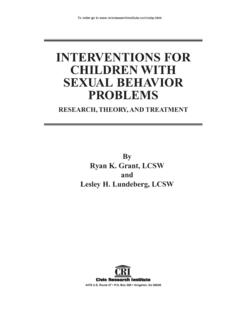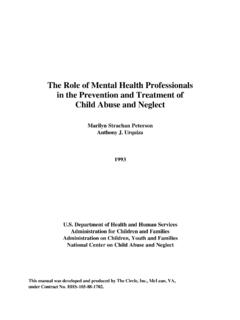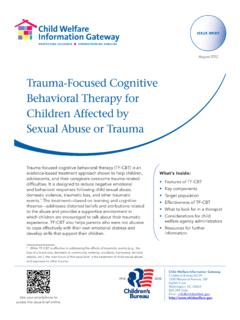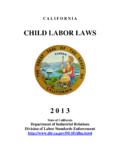Transcription of The Psychology of Human Sexuality - Rogue Community …
1 The Psychology of Human Sexuality By Don Lucas and Jennifer Fox Northwest Vista College Sexuality is one of the fundamental drives behind everyone s feelings, thoughts, and behaviors. It defines the means of biological reproduction, describes psychological and sociological representations of self, and orients a person s attraction to others. Further, it shapes the brain and body to be pleasure-seeking. Yet, as important as Sexuality is to being Human , it is often viewed as a taboo topic for personal or scientific inquiry. Share this URL: Alfred Kinsey Consent Fantasy Gender Masturbation Oral sex Paraphilia Sex sexual orientation Sexuality Learning Objectives Explain how scientists study Human Sexuality . Share a definition of Human Sexuality . Distinguish between sex, gender, and sexual orientation. Review common and alternative sexual behaviors. Appraise how pleasure, sexual behaviors, and consent are intertwined.
2 Introduction Sex makes the world go around: It makes babies bond, children giggle, adolescents flirt, and adults have babies. It is addressed in the holy books of the world s great religions, and it infiltrates every part of society. It influences the way we dress, joke, and talk. In many ways, sex defines who we are. It is so important, the eminent neuropsychologist Karl Pribram (1958) described sex as one of four basic Human drive states. Drive states motivate us to accomplish goals. They are linked to our survival. According to Pribram, feeding, fighting, fleeing, and sex are the four drives behind every thought, feeling, and behavior . Since these drives are so closely associated with our psychological and physical health, you might assume people would study, understand, and discuss them openly. Your assumption would be generally correct for three of the four drives (Malacane & Beckmeyer, 2016).
3 Can you guess which drive is the least understood and openly discussed? This module presents an opportunity for you to think openly and objectively about sex. Without shame or taboo, using science as a lens, we examine fundamental aspects of Human Sexuality including gender, sexual orientation, fantasies, behaviors, paraphilias, and sexual consent. The History of Scientific Investigations of Sex An image on an ancient Greek drinking cup of two lovers kissing. ca. 480 BC [Image: Marie-Lan Nguyen, ,Public Domain] The history of Human Sexuality is as long as Human history itself 200,000+ years and counting (Ant n & Swisher, 2004). For almost as long as we have been having sex, we have been creating art, writing, and talking about it. Some of the earliest recovered artifacts from ancient cultures are thought to be fertility totems. The Hindu Kama Sutra (400 BCE to 200 CE) an ancient text discussing love, desire, and pleasure includes a how-to manual for having sexual intercourse.
4 Rules, advice, and stories about sex are also contained in the Muslim Qur an, Jewish Torah, and Christian Bible. By contrast, people have been scientifically investigating sex for only about 125 years. The first scientific investigations of sex employed the case study method of research. Using this method, the English physician Henry Havelock Ellis (1859-1939) examined diverse topics within Sexuality , including arousal and masturbation. From 1897 to 1923, his findings were published in a seven-volume set of books titled Studies in the Psychology of Sex. Among his most noteworthy findings is that transgender people are distinct from homosexual people. Ellis s studies led him to be an advocate of equal rights for women and comprehensive Human Sexuality education in public schools. Using case studies, the Austrian neurologist Sigmund Freud (1856-1939) is credited with being the first scientist to link sex to healthy development and to recognize humans as being sexual throughout their lifespans, including childhood (Freud, 1905).
5 Freud (1923) argued that people progress through five stages of psychosexual development: oral, anal, phallic, latent, and genital. According to Freud, each of these stages could be passed through in a healthy or unhealthy manner. In unhealthy manners, people might develop psychological problems, such as frigidity, impotence, or anal-retentiveness. The American biologist Alfred Kinsey (1894-1956) is commonly referred to as the father of Human Sexuality research. Kinsey was a world-renowned expert on wasps but later changed his focus to the study of humans. This shift happened because he wanted to teach a course on marriage but found data on Human sexual behavior lacking. He believed that sexual knowledge was the product of guesswork and had never really been studied systematically or in an unbiased way. He decided to collect information himself using the survey method, and set a goal of interviewing 100 thousand people about their sexual histories.
6 Although he fell short of his goal, he still managed to collect 18 thousand interviews! Many behind closed doors behaviors investigated by contemporary scientists are based on Kinsey s seminal work. Today, a broad range of scientific research on Sexuality continues. It s a topic that spans various disciplines, including anthropology, biology, neurology, Psychology , and sociology. Sex, Gender, and sexual Orientation: Three Different Parts of You Applying for a credit card or filling out a job application requires your name, address, and birth-date. Additionally, applications usually ask for your sex or gender. It s common for us to use the terms sex and gender interchangeably. However, in modern usage, these terms are distinct from one another. Cartoon depicting a traditional gender role of a woman as a housewife, working in the kitchen. [Image: JosephineRN28, , CC BY-SA , ] Sex describes means of biological reproduction.
7 Sex includes sexual organs, such as ovaries defining what it is to be a female or testes defining what it is to be a male. Interestingly, biological sex is not as easily defined or determined as you might expect (see the section on variations in sex, below). By contrast, the term gender describes psychological (gender identity) and sociological (gender role) representations of biological sex. At an early age, we begin learning cultural norms for what is considered masculine and feminine. For example, children may associate long hair or dresses with femininity. Later in life, as adults, we often conform to these norms by behaving in gender-specific ways: as men, we build houses; as women, we bake cookies (Marshall, 1989; Money et al., 1955; Weinraub et al., 1984). Because cultures change over time, so too do ideas about gender. For example, European and American cultures today associate pink with femininity and blue with masculinity.
8 However, less than a century ago, these same cultures were swaddling baby boys in pink, because of its masculine associations with blood and war, and dressing little girls in blue, because of its feminine associations with the Virgin Mary (Kimmel, 1996). Sex and gender are important aspects of a person s identity. However, they do not tell us about a person s sexual orientation (Rule & Ambady, 2008). sexual orientation refers to a person s sexual attraction to others. Within the context of sexual orientation, sexual attraction refers to a person s capacity to arouse the sexual interest of another, or, conversely, the sexual interest one person feels toward another. While some argue that sexual attraction is primarily driven by reproduction ( , Geary, 1998), empirical studies point to pleasure as the primary force behind our sex drive. For example, in a survey of college students who were asked, Why do people have sex?
9 Respondents gave more than 230 unique responses, most of which were related to pleasure rather than reproduction (Meston & Buss, 2007). Here s a thought-experiment to further demonstrate how reproduction has relatively little to do with driving sexual attraction: Add the number of times you ve had and hope to have sex during your lifetime. With this number in mind, consider how many times the goal was (or will be) for reproduction versus how many it was (or will be) for pleasure. Which number is greater? Although a person s intimate behavior may have sexual fluidity changing due to circumstances (Diamond, 2009) sexual orientations are relatively stable over one s lifespan, and are genetically rooted (Frankowski, 2004). One method of measuring these genetic roots is the sexual orientation concordance rate (SOCR). An SOCR is the probability that a pair of individuals has the same sexual orientation.
10 SOCRs are calculated and compared between people who share the same genetics (monozygotic twins, 99%); some of the same genetics (dizygotic twins, 50%); siblings (50%); and non-related people, randomly selected from the population. Researchers find SOCRs are highest for monozygotic twins; and SOCRs for dizygotic twins, siblings, and randomly-selected pairs do not significantly differ from one another (Bailey et al. 2016; Kendler et al., 2000). Because sexual orientation is a hotly debated issue, an appreciation of the genetic aspects of attraction can be an important piece of this dialogue. On Being Normal: Variations in Sex, Gender, and sexual Orientation Only the Human mind invents categories and tries to force facts into separated pigeon-holes. The living world is a continuum in each and every one of its aspects. The sooner we learn this concerning Human sexual behavior , the sooner we shall reach a sound understanding of the realities of sex.








